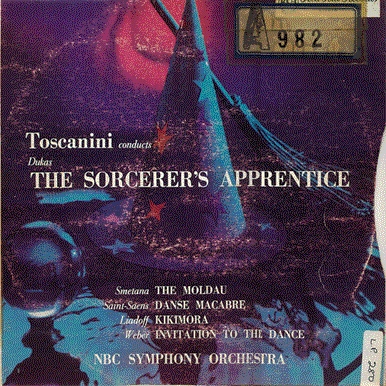Side 1, Band l—Dukas The Sorcerer's Apprentice
(L'Apprenti Sorcier).
Paul Dukas, the French Composer, who wrote his Sorcerer's Apprentice in
1897, called this orchestral work a Scherzo. "Scherzo", in Italian,
rreans "joke", and that is
what The Sorcerer's Apprentice is—a joke in music. It is also one of the
most brilliant pieces of programme music in the repertoire. Dukas took
the story, upon which
the music is based, from a poem by Goethe, but the original story goes
way back to the Roman Empire. In a work by Lucian there is an account of
a man ordering a
magician's pestle to bring water, which it does until the place is
flooded. Splitting the pestle in two with an axe did not help matters
much, for each half fetched water on
its own, and it took the return of the magician to stop the magic.
Goethe's story is very similar.
Dukas' The Sorcerer's Apprentice is justly hailed as one of the
masterpieces of descriptive music. It is written with wit and polish,
and with thematic originality.
Musicians have always admired the technique with which Dukas was able to
weave his story into his music without cheapening the musical content;
while audiences, not
in the least concerned about technical problems, have always admired the
score for its fluency and immediately ingratiating qualities.
Side 1, Band 2—Smetana The Moldau (No. 2 from the Symphonic Cycle "My
Country").
The Moldau is probably Smetana's most popular orchestral work, and his
most beautiful, too. Smetana, the first of the great Bohemian'
nationalists, commemorated his
love for his country in a set of six symphonic poems named My
Fatherland, composed between 1874 and 1879. The Moldau is the second. •
Poor Smetana never heard a note of The Moldau. Late in 1874 total
deafness suddenly hit him. Smetana lived for ten more years, his mind
gradually slipping; like
Beethoven, he was deaf, and like Schumann, he died in an insane asylum.
Nevertheless, during his affliction, he went on to compose My
Fatherland; his opera, The Kiss;
and his moving string quartet in E minor, From my Life. And certainly
The Moldau, with its joy and lyricism, its sweetness and identification
with the Czech spirit, does
not sound like the product of a suffering man who must hash known that
the end was not too far off.
Side 2, Band 1—Saint-Saens Danse Macabre, Op. 40 (Dance of Death). It is
not generally known, but Saint-Saens originally composed his
Danse Macabre. one of his most popular orchestral works, rs a song. He
had read a poem by Henri Cazalis, which, translated into English, runs
as follows: "Zig, zig, zig,
Death is striking a tomb with his heel in cadence. Death is playing a
dance tune on his violin at midnight. The winter wind blows, and the
night is dark. From the linden
trees come moans. White skeletons move across the shadows, running and
leaping' in their shrouds. Zig, zig, zig, each one gives a tremor, and
the dancers' bones rattle.
Hush! they suddenly leave off dancing, they jostle one another, they
flee--the cock has crowed."
Saint-Saens wisely decided that the orchestra would much better describe
these nocturnal goings-on, and so he revised the work, completing it in
1874. His musical
treatment closely follows the action of the poem.
Side 2, Band 2—Liadoff Kikimora, Op. 63 (Legend for Orchestra).
The Russian Composer Anatol Liadoff was much engrossed in Russian
folk-lore and folk music, which inspired most of his works. His "Legend
for Orchestra",
K::k,nrora, receives its greatest charm from the unique orchestration,
which Liadoff undoubtedly learned from his distinguished teacher,
Rimsky-Korsakoff.
According to the legend, Kikimora was a precocious and evil-minded
female with a head no bigger than a thimble and a body as thin as a
straw. Shegrew to maturity in
seven years, thanks to the information she gained from daily conferences
with an omniscient feline, who related many strange tales of far and
wonderful places.
Side 2, Band 3—Weber Invitation to the Dance, Op. 65 (Orchestrated by
Berlioz).
The German composer Carl Maria von Weber made his greatest contributions
to music literature with his highly romantic operas. Yet his most
enduring composition is
the blithe and colorful Invitation to the Dance. originally composed for
the piano and later orchestrated by both Hector Berlioz and Felix
Weingartner.
The scene of the charming composition is a ball in typical
nineteenth-century fashion: a young man approaches the lady of his
heart, converses prettily with her and.
asks the honour of a dance; she assents most graciously, they dance, he
thanks her kindly, and they retire.
Copyright Radio Corporation of America.
Enjoy these six great concert favourites!MANUFACTUED IN AUSTRALIA -
PRODUCT OF RCA OF AUSTRALIA PTY LTD USE OF MASTER RECORDINGS AND
TRADEMARKS AUTHORIZED BY RADIO CORPORATION OF AMERICA - RECORDED BY
CORPORATION OF AMERICA
L1 6076 |




